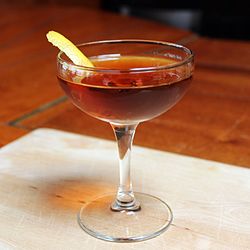
A Manhattan is a cocktail made with whiskey, sweet vermouth, and bitters. While rye is the traditional whiskey of choice, other commonly used whiskies include Canadian whisky, bourbon, blended whiskey, and Tennessee whiskey. The cocktail is usually stirred then strained into a cocktail glass and garnished traditionally with a maraschino cherry. A Manhattan may also be served on the rocks in a lowball glass.
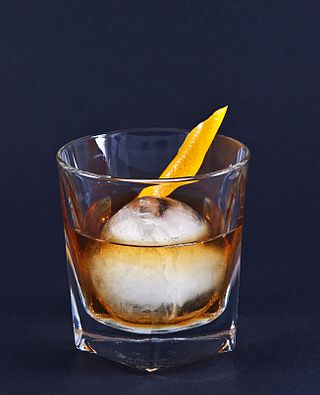
The old fashioned is a cocktail made by muddling sugar with bitters and water, adding whiskey, and garnishing with an orange slice or zest and a cocktail cherry. It is traditionally served with ice in an old fashioned glass.

The Rob Roy is a cocktail consisting primarily of whisky and vermouth, created in 1894 by a bartender at the Waldorf Astoria in Manhattan, New York City. The drink was named in honor of the premiere of Rob Roy, an operetta by composer Reginald De Koven and lyricist Harry B. Smith loosely based upon Scottish folk hero Rob Roy MacGregor.
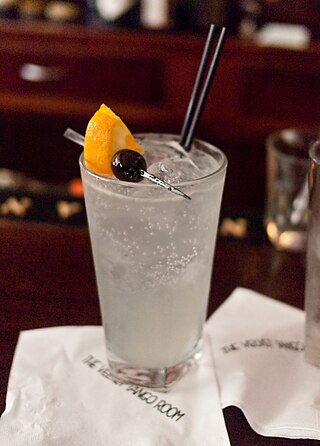
The Tom Collins is a Collins cocktail made from gin, lemon juice, sugar, and carbonated water. First memorialized in writing in 1876 by Jerry Thomas, "the father of American mixology", this "gin and sparkling lemonade" drink is typically served in a Collins glass over ice. A non-alcoholic "Collins mix" mixer is produced, enjoyed by some as a soft drink.

The martini is a cocktail made with gin and vermouth, and garnished with an olive or a lemon twist. Over the years, the martini has become one of the best-known mixed alcoholic beverages. A popular variation, the vodka martini, uses vodka instead of gin for the cocktail's base spirit.

The Singapore sling is a gin-based sling cocktail from Singapore. This long drink was developed sometime before 1915 by Ngiam Tong Boon, a bartender at the Long Bar in Raffles Hotel, Singapore. It was initially called the gin sling.
Pink gin was historically used to reference a type of cocktail made fashionable in England in the mid-19th century, consisting of Plymouth gin and a dash of Angostura bitters, a dark red bitters that makes the whole drink pinkish. In recent years, the term Pink gin has also been used to define a specific category of gin where a range of fruits and flavourings are infused into the gin to give it a pink color.
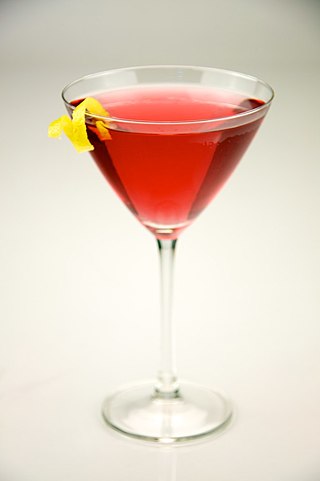
A cosmopolitan, or, informally, a cosmo, is a cocktail made with vodka, Cointreau, cranberry juice, and freshly squeezed or sweetened lime juice.
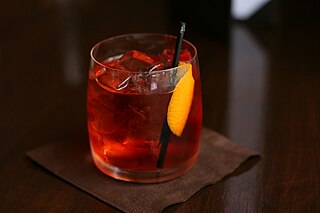
A Negroni is an Italian cocktail, made of one part gin, one part vermouth rosso and one part Campari, garnished with orange peel. It is considered an apéritif.

The hanky panky is a cocktail made from gin, sweet vermouth, and Fernet-Branca. It is a variation on the sweet martini, or Martinez, made distinctive by the Fernet-Branca, a bitter Italian digestivo. It was created by Ada "Coley" Coleman, head bartender at the Savoy Hotel, London.

The Prince of Wales is a cocktail created by Albert Edward, Prince of Wales, who later became King Edward VII. There are several variations of the cocktail, but what they usually have in common is champagne, angostura bitters, sugar, either rye whiskey or cognac, and a liqueur.

The Fine Art of Mixing Drinks is a book about cocktails by David A. Embury, first published in 1948. The book is noteworthy for its witty, highly opinionated and conversational tone, as well as its categorization of cocktails into two main types: aromatic and sour; its categorization of ingredients into three categories: the base, modifying agents, and special flavorings and coloring agents; and its 1:2:8 ratio for sour type cocktails.
The brandy daisy is a cocktail which first gained popularity in the late 19th century. One of the earliest known recipes was published in 1876 in the second edition of Jerry Thomas's The Bartenders Guide or How To Mix Drinks: The Bon-Vivants Companion:
Fill glass half full of shaved ice. Shake well and strain into a glass, and fill up with Seltzer water from a syphon.

A champagne cocktail is an alcoholic cocktail made with sugar, Angostura bitters, Champagne, brandy, and a maraschino cherry as a garnish. It is one of the IBA official cocktails. Other variations include Grenadine, Orange bitters, Cognac or Sparkling wine. Other nonofficial garnishes include strawberries or dried orange slices.

The Malecon is a cocktail named after the El Malecón, the winding beachfront avenue atop the seawall in Havana, Cuba.
The corpse reviver family of named cocktails are sometimes drunk as alcoholic hangover tongue-in-cheek "cures", of potency or characteristics to be able to revive even a dead person. Some corpse reviver cocktail recipes have been lost to time, but several variations commonly thought to be tied to the American Bar at the Savoy Hotel remain, especially those espoused by Harry Craddock that originally date back to at least 1930 and are still being made. Many "reviver" variations exist and the word is sometimes used as a generic moniker for any morning-after cocktail, also known as a "hair of the dog".
A Boomerang cocktail is a specific cocktail dating back to the early 20th century. In the 21st century, it may also be a reference to cocktails that bartenders illegally shuttle back and forth between bars as a way of sharing experimentation or building comradery.

Zig Zag Café is a craft cocktail bar and restaurant in Seattle, Washington. Established in 1999, the bar is considered one of the best in the United States, helping lead the craft cocktail movement. From 2002 to 2011, noted bartender Murray Stenson worked at Zig Zag Café, and created innovative cocktails as well as reintroduced the pre-Prohibition-era Last Word cocktail to the public and to bars around the world.
